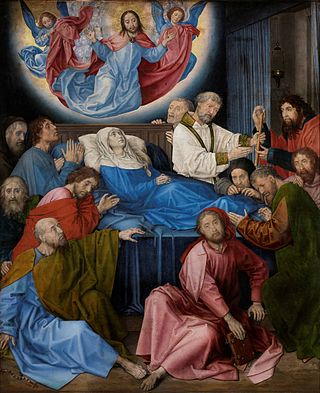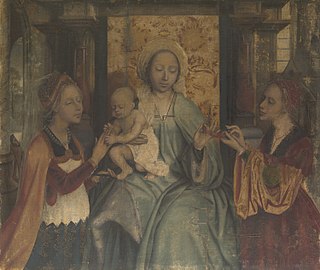
Chiaroscuro, in art, is the use of strong contrasts between light and dark, usually bold contrasts affecting a whole composition. It is also a technical term used by artists and art historians for the use of contrasts of light to achieve a sense of volume in modelling three-dimensional objects and figures. Similar effects in cinema, and black and white and low-key photography, are also called chiaroscuro.

The Kunsthistorisches Museum is an art museum in Vienna, Austria. Housed in its festive palatial building on the Vienna Ring Road, it is crowned with an octagonal dome. The term Kunsthistorisches Museum applies to both the institution and the main building. It is the largest art museum in the country and one of the most important museums worldwide.

Petrus Christus was an Early Netherlandish painter active in Bruges from 1444, where, along with Hans Memling, he became the leading painter after the death of Jan van Eyck. He was influenced by van Eyck and Rogier van der Weyden and is noted for his innovations with linear perspective and a meticulous technique which seems derived from miniatures and manuscript illumination. Today, some 30 works are confidently attributed to him. The best known include the Portrait of a Carthusian (1446) and Portrait of a Young Girl ; both are highly innovative in the presentation of the figure against detailed, rather than flat, backgrounds.

The Adoration of the Shepherds, in the Nativity of Jesus in art, is a scene in which shepherds are near witnesses to the birth of Jesus in Bethlehem, arriving soon after the actual birth. It is often combined in art with the Adoration of the Magi, in which case it is typically just referred to by the latter title. The Annunciation to the Shepherds, when they are summoned by an angel to the scene, is a distinct subject.
"Ecce homo", is a phrase traditionally attributed to Pontius Pilate at the trial of Jesus.

Death of the Virgin (1606) is a painting by the Italian Baroque master Caravaggio depicting the death of the Virgin Mary. It is part of the permanent collection of the Musée du Louvre, in Paris.

The Death of the Virgin Mary is a common subject in Western Christian art, the equivalent of the Dormition of the Theotokos in Eastern Orthodox art. This depiction became less common as the doctrine of the Assumption gained support in the Roman Catholic Church from the Late Middle Ages onward. Although that doctrine avoids stating whether Mary was alive or dead when she was bodily taken up to Heaven, she is normally shown in art as alive. Nothing is said in the Bible about the end of Mary's life, but a tradition dating back to at least the 5th century says the twelve Apostles were miraculously assembled from their far-flung missionary activity to be present at the death, and that is the scene normally depicted, with the apostles gathered round the bed.

The Death of the Virgin is a painting by the Italian Renaissance painter Andrea Mantegna, dating to c. 1462–1464.

The National Gallery is the primary British national public art gallery, sited on Trafalgar Square, in central London. It is home to one of the world's greatest collections of Western European paintings. Founded in 1824, from an initial purchase of 36 paintings by the British Government, its collections have since grown to about 2,300 paintings by roughly 750 artists dating from the mid-13th century to 1900, most of which are on display. This page lists some of the highlights of the collection.

The art of the Low Countries consists of painting, sculpture, architecture, printmaking, pottery and other forms of visual art produced in the Low Countries, and since the 19th century in Belgium in the southern Netherlands and the Netherlands in the north.

The account of the beheading of Holofernes by Judith is given in the deuterocanonical Book of Judith, and is the subject of many paintings and sculptures from the Renaissance and Baroque periods. In the story, Judith, a beautiful widow, is able to enter the tent of Holofernes because of his desire for her. Holofernes was an Assyrian general who was about to destroy Judith's home, the city of Bethulia. Overcome with drink, he passes out and is decapitated by Judith; his head is taken away in a basket.
Portrait of a Young Woman may refer to:

The Death of the Virgin is an oil-on-oak-panel painting by the Flemish painter Hugo van der Goes. Completed c 1472–1480, it shows the Virgin Mary on her deathbed surrounded by the Twelve Apostles. The scene is borrowed from Jacobus de Voragine's thirteenth-century "Legenda aurea" which relates how the apostles were brought, at Mary's request, on clouds by angels to a house near Mount Zion to be with her in her final three days. On the third day Jesus appeared above her bed in a halo of light surrounded by angels to accept her soul at the point when his name was finally mentioned. Three days later he reappeared to accept her body.

Glue-size is a painting technique in which pigment is bound (sized) to cloth with hide glue, and typically the unvarnished cloth was then fixed to the frame using the same glue. Glue-size is also known as distemper, though the term "distemper" is applied variously to different techniques. Glue-size was used because hide glue was a popular binding medium in the 15th century, particularly among artists of the Early Netherlandish period, who used it as an inexpensive alternative to oil. Although a large number of works using this medium were produced, few survive today, mainly because of the high perishability of linen cloth and the solubility of hide glue. Well-known and relatively well-preserved – though substantially damaged – the most notable examples include Quentin Matsys' Virgin and Child with Saints Barbara and Catherine and Dirk Bouts' Entombment. In German the technique is known as Tüchleinfarben, meaning “small cloth colours”, or Tüchlein, derived from the German words Tüch and Lein.

Madonna of the Dry Tree or Our Lady of the Barren Tree is a small oil-on-oak panel painting dated c. 1462–1465, attributed to the Early Netherlandish painter Petrus Christus. Itt shows the Virgin Mary and the Christ Child standing on a disembodied dead tree trunk. The painting's imagery is unusually dark and dramatic and shows a encircled woman within folds of black and withered branches that may represent a crown of thorns.

Lucretia is a 1666 history painting by the Dutch Golden Age painter Rembrandt Harmensz van Rijn in the collection of the Minneapolis Institute of Art. It is an oil painting on canvas that depicts a myth about a woman named Lucretia who lived during the ancient Roman eras. She committed suicide to defend her honor after being raped by an Etruscan king's son. For her self-sacrifice she is known as a heroine to the Romans, who celebrated the feminine ideals of virtue and chastity.
Keith Christiansen is an American art historian, curator, and author. He is the chairman of the department of European paintings at New York City's Metropolitan Museum of Art.
The Adoration of the Magi is a subject in Christian art.














